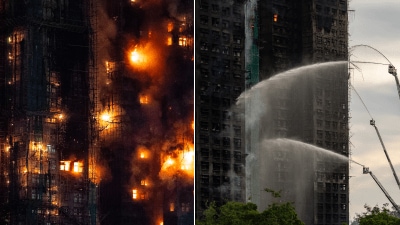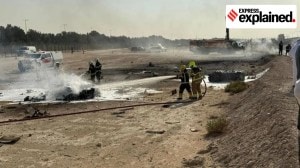Lok Sabha: Master Plan to tackle annual floods in Ghatal could prove key in deciding who wins polls in this Bengal TMC bastion
The focus on Ghatal is prominent in the run-up to the Lok Sabha elections this year in part because of the candidates in the fray, Deepak Adhikari and Hiranmoy Chattopadhyay, who are popular actors in the Bengali film industry.
 The Shilabati River in Paschim Medinipur. (Photo credit: Neha Banka)
The Shilabati River in Paschim Medinipur. (Photo credit: Neha Banka)In West Bengal’s Ghatal subdivision, some 120 km west of Kolkata, it is difficult to find a home that has never experienced floods. In villages in this area, every family has a story to tell of their house being submerged in flood water year after year, and little has changed over the decades.
“Ask me how difficult it is to live here,” says 55-year-old Champa Singh, who lives on the outskirts of Ghatal town in Ajabnagar village. The Ghatal region, located at the base of the Chota Nagpur Plateau, is highly vulnerable to recurring floods that wash away everything in its path. The worst affected are residents living on and below the poverty line. But this year, these annual floods and promises by political parties to help curb the destruction that they bring to the people of this region, are key issues that voters will be considering when Paschim Medinipur goes to the polls in the sixth phase on May 25.
“When the water enters homes, we have to climb up to the roof and tie a tirpal and sit underneath it. Despite the tirpal, we get wet when it rains,” says Singh. Almost all new construction in this region involves building structures on concrete stilts to escape flood water. For older homes and buildings, the ground floor is left unoccupied to prevent damage during floods.
 Champa Singh, who lives on the outskirts of Ghatal town in Ajabnagar village, gives shelter to her neighbours during floods on her rooftop. (Photo credit: Neha Banka)
Champa Singh, who lives on the outskirts of Ghatal town in Ajabnagar village, gives shelter to her neighbours during floods on her rooftop. (Photo credit: Neha Banka)
The Ghatal region receives a significant amount of rainfall every year between the months of June and September when the southwest-led monsoon is most active. During the post-monsoon months of October and November, tropical cyclones originating in the Bay of Bengal frequently bring torrential rainfall to this part of the state. In addition, a network of rain-fed east-flowing rivers, like the Shilabati, Dwarkeshwar and Rupnarayan, mean that the Ghatal subdivision is frequently flooded, with flood waters remaining stagnant for a long time owing to the typical basin-shaped topography of the area.
Months before every election, Ghatal’s residents say political parties arrive with their electoral campaigns and promises that they are never able to keep. This year, in the run-up to the Lok Sabha elections, particularly in West Bengal, the focus on Ghatal has been prominent, in part because of its star campaigners, both very popular faces in the Bengali film industry. Dev, also known as Deepak Adhikari, and Hiran also known as Hiranmoy Chattopadhyay, are contesting the Lok Sabha elections from the Ghatal Lok Sabha seat. Dev, the sitting Trinamool Congress (TMC) MP is seeking re-election from the seat while the BJP has nominated Kharagpur MLA Hiran to take on him head-on.
The ‘Master Plan’
For the star campaigners, first up on the list of promises made to the people of this constituency is the Ghatal Master Plan, initially proposed by the West Bengal government in 1977, when the CPI(M) came to power. But in the five decades since, there has been little progress on this front.
The Ghatal Master Plan is an ambitious, expensive project that would involve the dredging of riverbeds and the strengthening of embankments that engineers believe would help curb the devastating floods that besiege the region every year, the cost for which has been presently estimated at Rs 1,500 crore.
“This is a neglected issue. When the Left Front was in power, we tried a lot to get this done. I can ask the Left Front government why even in 36 years they could not. Before that, the Congress was in power for 30 years. The fund distribution back then was supposed to be at a 60-40 ratio, where 60 per cent would be paid by the central government and 40 per cent would be paid by the West Bengal government,” says Ashok Santra, a long-term CPI(M) worker and Ghatal resident.
After the Trinamool Congress came to power in 2011, a year later, the West Bengal government sent a detailed project report to the Centre on the Ghatal Master Plan, estimated at Rs 1,200 crore back then. Initially, the Centre agreed to take up the project with a 75-25 expenditure ratio between the Centre and the state government, but the funding pattern was changed to a 50-50 ratio after the BJP-led NDA government came to power in 2014. However, the central government did not release any funds for the project till 2023.
 A home built on concrete stilts to prevent flood water from entering the structure in Paschim Medinipur. (Photo credit: Neha Banka)
A home built on concrete stilts to prevent flood water from entering the structure in Paschim Medinipur. (Photo credit: Neha Banka)
“But regardless of who was in power at the Centre, they never wanted to give the funds for this project. It is not possible for the state government to do this alone because of the amount of money involved,” says Santra. He is referring to Chief Minister Mamata Banerjee’s statement issued in February this year when she said the state government would implement the Ghatal Master Plan using its own resources as the Centre is yet to respond to the longstanding demand, which local MP Dev has tried to push in the last 10 years.
Forty minutes from Ghatal town, some 600 residents live in homes made of bricks and mud in Nimpata village along the Shilabati River. In small water bodies in this village, narrow wooden boats and indigenous boats made using dried palm bark are the only modes of transportation when the floods arrive. But in the villages of the Ghatal constituency, only the privileged can afford a boat to cope with the flood season.
 Wooden boats in Nimpata village, owned by privileged residents, that are used during floods for transportation. (Photo credit: Neha Banka)
Wooden boats in Nimpata village, owned by privileged residents, that are used during floods for transportation. (Photo credit: Neha Banka)
“Only people who live in this village can understand why this Master Plan is important. Politicians will never be able to do that. That is my house and I have lived here all my life. This time of the year is a good time in terms of weather because right now you can’t see the disaster,” says 35-year-old Radhanath Doloi.
There are several rivers in the south-west portion of West Bengal that originate in the Chota Nagpur Plateau, including the Shilabati, Damodar, Dwarkeshwar, Rupnarayan, etc and constitute the western tributaries of the Bhagirathi-Hooghly River. While all have an impact on people, crops and property during the monsoon months, that of the Damodar River is the most severe.
To curb its impact on human life, the Damodar Valley Corporation (DVC) was formed in 1948, a process that had started during British rule in 1943, before Independence, in accordance with suggestions of a search committee. In the 1950s, in the south of the DVC’s command areas, the Kangsabati Project was put in place by the West Bengal’s Department of Irrigation and Waterways to regulate water flow in Paschim Medinipur, Purba Medinipur, Bankura, Purulia and Hooghly districts. As a part of these two projects, a number of reservoirs were constructed in upstream areas of both the Damodar and Kangsabati rivers and their tributaries.
The Ghatal region is located in the eastern extremities of the Kangsabati Project’s command area. The Rupnarayan River, the region’s main drainage outlet, is fed by the water of both the DVC and Kangsabati Project, brought in by the southeast-flowing Dwarkeshwar River and the east-flowing Shilabati River, says Dr Sayantan Das, assistant professor at Dum Dum Motijheel College’s Department of Geography. The release of excess discharge from the upstream reservoirs of the DVC and Kangsabati Project causes prolonged waterlogging in the Ghatal administrative block.
“High tide water from the sea enters the region through the Rupnarayan River, and reaches the Shilabati River and Dwarkeshwar River. Even if the flood water tries to exit through these rivers, tidal waters enter from the opposite side blocking it,” says Das. Every day, in intervals of 12.5 hours, the tidal waters come into the rivers making it difficult for the water to drain, worsening the floods and stagnant water.
“The flood reaches all the way up to Howrah’s Udaynarayanpur,” says Das. “The administrative areas of Ghatal town usually do not get stagnant flood water because it is at a high elevation. Also, satellite images will show that sometimes flood water remains in patches till November.”
In August 2021, devastating floods breached at least 10 embankments alongside four blocks of the Ghatal sub-division, in Daspur-1, Ghatal, Chandrakona-1, Chandrakona-2 as well as the Kharar municipality’s wards.
 An indigenous bridge across the Shilabati River in Ghatal town, Paschim Medinipur. (Express photo by Neha Banka)
An indigenous bridge across the Shilabati River in Ghatal town, Paschim Medinipur. (Express photo by Neha Banka)
“Till date, no villager here knows what the Master Plan is. Only the government and their associates know. We don’t even know how the Master Plan will be implemented. The only thing an ordinary villager here knows is that if the master plan comes the floods will decrease,” says Doloi.
“The water flowing into Panna and Ajabnagar is coming from Shilabati, Kangsabati and Dwarkeshwar rivers. The floods occur because during the monsoon, the water is collected here. The water volume increases because of the rain, but the main agent is the transported water from the Shilabati, Kangsabati valley. These villages are in the catchment area of these rivers. The catchment water which is coming down in this region, following the regional slope, is the primary source of flood water and the rainwater only adds to its volume. The water descends very slowly because the regional topography is very flat and when the rainwater is added on top of that, the volume of the water increases. It then heads towards the Rupnarayan River and just when it reaches, it is met with tidal water. So these factors together cause massive floods in these villages,” says Das.
Campaigning around Ghatal’s ‘Master Plan’
In early April this year, large political posters came up all across Ghatal town, including on the grounds of the Ghatal Vidyasagar High School, featuring Mamata Banerjee and Dev with a caption in bold lettering: ‘Dev; Master Plan Champion’. The poster, specifically its caption and the use of the word ‘champion’, received criticism from several residents interviewed by indianexpress.com, who accused the TMC of misleading voters by implying that the Ghatal Master Plan had been completed or was close to completion.
 A poster in Ghatal town with the caption ‘Dev; Master Plan Champion’. (Photo credit: Neha Banka)
A poster in Ghatal town with the caption ‘Dev; Master Plan Champion’. (Photo credit: Neha Banka)
“Ignore what the politicians say. What do they even understand about floods? Dev lives in Kolkata, Hiran stays in Kharagpur. Do floods happen in Kolkata and Kharagpur? They have come here to be the Member of Parliament from Ghatal. Regardless of who comes to power, only a politician who lives here, who knows the ground-level situation can really understand what our lives are like,” says Doloi.
Battle of the stars
In February this year, there was speculation about Dev’s political future, in part because of his cryptic social media post with the caption ‘My last day in Parliament’. Back then, Dev had said, “This is my last speech in Parliament. I have consistently advocated for the Ghatal Master Plan since day one. It is not just a TMC or BJP concern; it is about the welfare of the people.”
 BJP campaign flags in Ajabnagar village, Paschim Medinipur, West Bengal. (Photo credit: Neha Banka)
BJP campaign flags in Ajabnagar village, Paschim Medinipur, West Bengal. (Photo credit: Neha Banka)
“It is true that Dev did not want not to contest (the elections) this time. He said this several times in front of the media and even went on to declare that he was going to leave politics. But then he met Abhishek Banerjee and changed his mind. According to Dev, the TMC party leadership assured him that the Ghatal Master Plan would be implemented and that is why he is contesting this time,” says Spandan Roy Basunia, a political analyst in West Bengal.
Dilip Majhi, a Trinamool worker, grew up in Ajabnagar-II and witnessed floods all his life. “We are bringing this up because this is an important issue for us. I am pleading as a resident of Ghatal, not as a TMC person,” he says.
Majhi says his party is not concerned about the BJP in this constituency, even though the saffron party decided to field actor Hiran. “Dev is a superstar. How many films has Hiran done? Just doing a few songs doesn’t make someone a film star. So there is no comparison. Countless people come to meet Dev when he comes for campaigns. I will not say that just because people are coming, they are going to vote for him. But from where we are standing, we think Dev will win with a margin of more than two lakh votes here,” he adds.
“As a rural Lok Sabha constituency, Ghatal was never in the focus as much as it is now. But the nomination of Dev as TMC candidate in 2014 changed things. So, prior to Dev’s arrival, this seat was not considered important,” says Basunia. Prior to 2014, Ghatal was a Left Front citadel. But with the start of the decline of the Left Front’s power in 2009, TMC managed to make political inroads into a constituency that had been previously impossible for them to breach.
In Paschim Medinipur’s Mansuka village, BJP politician Sital Kopat is busy going door to door with his campaigning. “The BJP has constructed the Ram Mandir. There have been a lot of schemes implemented for Muslim daughters and mothers. Modi-ji has made toilets in every house under the Swachh Bharat Mission. We want everyone’s support to vote BJP into power in West Bengal,” Kopat tells a group of Mansuka residents in the local market.
“I am campaigning here and people know that Modi ji is thinking about the Master Plan and that Hiran is our representative. We want to say ‘bye bye’ to Deepak Adhikari. Let Hiran win if you have trust and faith in us. Not faith in us, but trust and faith in Modi-ji, because all guarantees can fail but not Modi-ji’s guarantee. People aren’t voting for Hiran but for Modi-ji,” says Kopat.
All over Ghatal are political advertisements pushing claims of the success of welfare schemes implemented by the Mamata Banerjee government. Most commonly visible here are those highlighting the Lakshmir Bhandar, a scheme initiated by the West Bengal Government in February 2021 to offer financial support to women between the ages of 25 and 60 who belong to economically disadvantaged segments of the society.
“Like any other constituency, this time issues are local. In Bengal, elections have always been state government-centric. Apart from the Ghatal Master Plan, welfare schemes of the TMC government, especially Lakshmir Bhandar, will be a major voting issue in a rural constituency like Ghatal,” says Basunia.
In addition, major talking points in rural constituencies against the TMC government are the teachers’ recruitment scam, the ration distribution scam and the coal scam. “The Ghatal Master Plan has always been a major voting issue here. Neither the Central government nor the state government has been able to implement it,” says Basunia.
“It is true that since 2011, the TMC has been winning in Ghatal quite comfortably. But rather than calling it a TMC stronghold, I would like to call it a stronghold of the ruling party. You can say seats like Kolkata Dakshin or Jadavpur are TMC strongholds because the TMC used to win these seats even before coming to power, but not in Ghatal. Therefore, the importance of this seat lies in the fact that if the ruling party loses this seat then it is a clear red flag for them,” says Basunia.
“People are voting here for celebrities. But these celebrities don’t have any relatability with common people. Villagers are uneducated and helpless. All they think about is the two handfuls of rice that they can eat. They aren’t able to fully think about their children’s futures and how things happening around them can impact their lives,” says Doloi.
- 01
- 02
- 03
- 04
- 05































